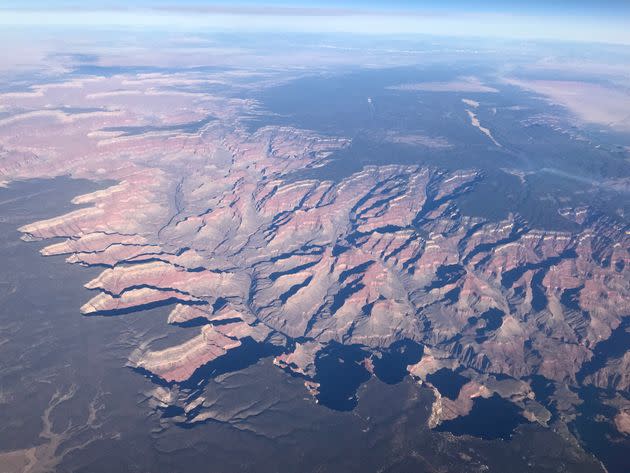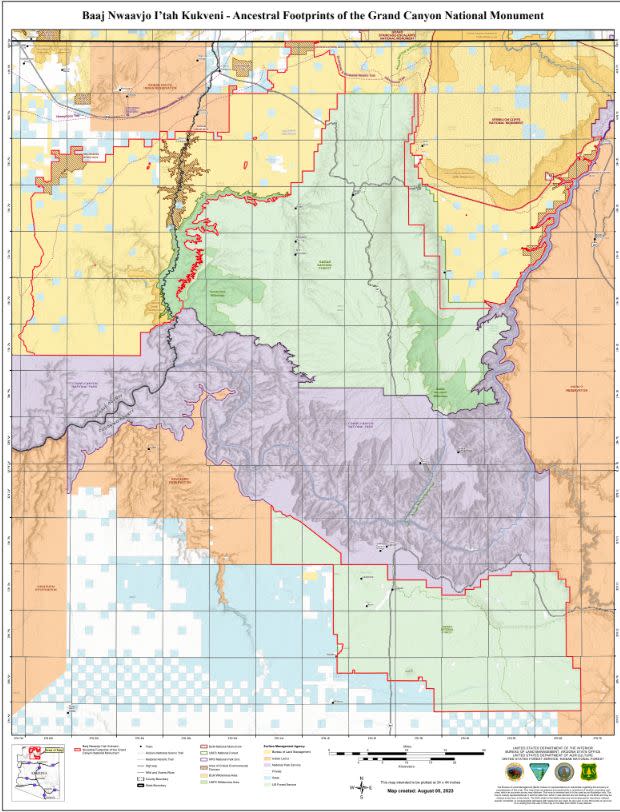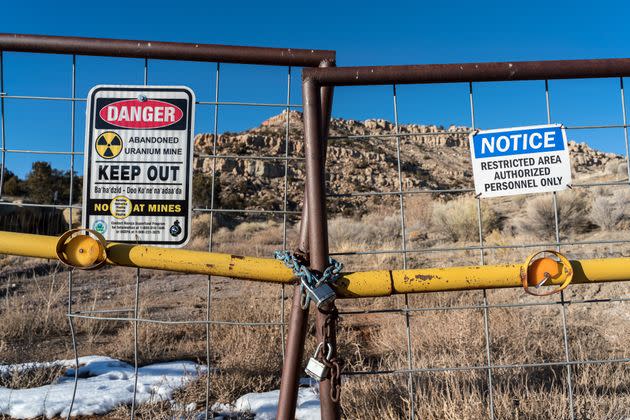Biden’s Newest National Monument Blocks Uranium Mining Near The Grand Canyon
- Oops!Something went wrong.Please try again later.
President Joe Biden on Tuesday established a new national monument protecting nearly 1 million acres of federal lands adjacent to Grand Canyon National Park from uranium mining and other development.
The site, named Baaj Nwaavjo I’tah Kukveni — Ancestral Footprints of the Grand Canyon National Monument, spans approximately 917,000 acres north and south of the park. It is Biden’s fifth national monument designation as president and advances the administration’s goal of protecting 30% of the nation’s lands and waters by 2030.
It will also “help address past injustices” by safeguarding Native American ancestral homelands, Interior Secretary Deb Haaland said during a call with reporters Monday.
“It will help protect lands that many tribes refer to as their eternal home, a place of healing and a source of spiritual sustenance,” Haaland said. “It will protect objects of historic and scientific importance for the benefit of tribes, the public and for future generations.”
Several area tribes, including the Havasupai, Hopi and Hualapai, have deep cultural and spiritual ties to the greater Grand Canyon landscape. “Baaj Nwaavjo” means “where tribes roam” in the Havasupai language. “I’tah Kukveni” means “our footprints” in Hopi. A coalition of tribes lobbied Biden to designate a monument using his power under the Antiquities Act of 1906, citing the potential adverse impacts of uranium extraction to cultural sites and water resources.
“The Grand Canyon region is sacred to each of us; it is a place where we see and understand our history,” the Grand Canyon Tribal Coalition said in a statement celebrating Biden’s action. “It is vital to our future as an eternal home and source of spiritual sustenance. Although many of our people were unjustly removed from these lands, our connections to this place and our responsibility to protect it remains strong.”
Biden signed a proclamation establishing the protected site during a visit to Arizona on Tuesday. He reflected on his first visit to the area as a young U.S. senator and said “there is no national treasure — none — that is grander than the Grand Canyon.”
“Over the years, hundreds of millions of people have traveled to the Grand Canyon, awed by its majesty,” Biden said. “But fewer are aware of its full history. From time immemorial, more than a dozen tribal nations have lived, gathered, prayed on these lands. But some 100 years ago they were forced out. That very act of preserving the Grand Canyon as a national park was used to deny Indigenous people full access to their homelands.”
“At a time when some seek to ban books and bury history, we’re making it clear that we can’t just choose to learn only what we want to know,” he added. “We should learn everything that’s good, bad and the truth about who we are as a nation.”
“Only with truth comes healing and justice.”

An aerial view of Kaibab National Forest, on the border of the Grand Canyon, in Arizona.
Biden’s designation effectively cements a 20-year mining ban that the Obama administration put in place in 2012. It will not affect existing mining claims or the two active mining operations within the monument’s boundary.
The monument will “preserve the status quo by not allowing new mining claims to be put into effect,” a senior administration official told reporters Monday, noting that the area contains 1.3% of the nation’s known uranium reserves.
But mining interests havecondemned Biden’s upcoming move, arguing it doesn’t square with the administration’s broader effort to combat climate change and boost carbon-free energy.
“The US is rich in uranium. But US nuclear plants use almost no domestic uranium, while Russia and its allies supply nearly 50%,” mining company Energy Fuels tweeted late last month. “The Biden Administration aims to support domestic nuclear & clean energy, but an ill-designed monument could hobble those efforts.”
Haaland, the first Native American Cabinet secretary in U.S. history, stressed the importance of Indigenous knowledge in public land management and said sites within the new monument are much more than a “passthrough on the way to the Grand Canyon.”
“They are sacred and significant in their own right,” Haaland said Monday. “They should not be opened to new mining claims and developed beyond recognition. We are in a new era, one in which we honor tribally led conservation, advance co-stewardship and care about the well-being of Native people.”

A map of Baaj Nwaavjo I’tah Kukveni – Ancestral Footprints of the Grand Canyon National Monument.
The United States’ fleet of just over 90 nuclear reactors ― the largest of any nation ― run primarily on uranium fuel imported from overseas. Kazakhstan provided 35% of U.S. nuclear fuel in 2021, the most recent year for which there are federal statistics, followed by Canada at 15%. Australia and Russia each provided another 14%. The U.S. produced just 5% of its own uranium.
That’s a big shift from the 1970s, when the U.S. imported virtually no uranium. Domestic production maxed out in 1980, when the country produced over 43 million pounds of uranium oxide. From there, production fell sharply, declining steadily throughout the 1990s as the Clinton-era “megatons for megawatts” program ― which saw the U.S. buy Russian nuclear fuel made of disassembled Soviet warheads ― priced U.S. fuel enrichers out of the market.
But that relationship made the U.S. and its allies so dependent on Russia that Rosatom, the state-owned nuclear company, has avoided the sanctions heaped on the Kremlin’s other energy businesses in the wake of Moscow’s invasion of Ukraine. Congress has given the Biden administration money to invest in domestic uranium supply chains, and lawmakers from both parties are pushing for more efforts to make the U.S. an alternative to Russia or China in nuclear technology.
In 2019, annual U.S. production of uranium oxide dropped below 1 million pounds for the first time since 1950, and has creeped lower since. Imports ― while down from a peak in 2004 ― ticked upward again in 2021.
The U.S. has shuttered more than a dozen reactors over the past decade as natural gas, made cheap by the fracking revolution, put atomic plants out of business ― part of a global trend of increasing fossil fuel usage to make up for lost nuclear output. But the race to get off planet-heating fossil fuels and stem the influx of blackouts in the U.S. has put a premium on the 24/7, carbon-free electricity nuclear reactors generate.
Between a wave of new government subsidies and the milestone completion of the country’s first “advanced” nuclear reactor last week in Georgia, the nuclear industry looks increasingly primed to reverse its downward trajectory.
If the U.S. revives its uranium industry to fuel its new or existing reactors, Arizona is a likely location for at least some future production. The northern region on the Colorado Plateau features what the Uranium Producers of America described as “the highest grade deposits identified in the United States.” The Grand Canyon sits right in the middle of the yellow-shaped area of a map that the trade group illustrated to show where ore can be found ― but the deposit stretches well beyond the contours of the new monument.
Other states with known uranium deposits include Colorado, Nebraska, New Mexico, Texas, Utah and Wyoming.
But in Arizona, uranium mining left a fraught legacy with Navajo people in particular, many of whom participated in early mining and were paid minimum wage or less and not given the same protective gear as non-Indigenous workers, according to a 2002 study funded through a federal grant and approved by an official Navajo Nation research review board.

Signs warning of health risks are posted outside the gates of an abandoned uranium mine in the community of Red Water Pond, New Mexico, in January 2020.
In June last year, the Environmental Protection Agency gave the Ute Mountain Ute tribe in Arizona a $75,000 grant to study whether the nation’s only remaining mill is responsible for an uptick in cancer in neighboring reservation communities. The results aren’t due until 2025.
It would be far from the first instance of the U.S. government’s decarbonization efforts coming into conflict with Native Americans against whom it waged genocidal wars just a few generations earlier. The Ave Kwa Ame monument Biden designated in March closed a sun-soaked region of Nevada off from solar development, despite proposals by a series of photovoltaics companies. Various tribes around the Silver State are fighting to block what could become the largest U.S. mine producing lithium, the key ingredient in electric-vehicle batteries which requires huge amounts of water to unearth.
The Grand Canyon Tribal Coalition, which includes a dozen area tribes, had advocated for a larger 1.1 million-acre monument boundary. Asked about the smaller footprint of Biden’s designation, a senior administration official said the monument does not include private or state lands and that “a lot of careful thought” was put into the final boundary.
The new monument follows Biden’s recent designations of the Emmett Till and Mamie Till-Mobley National Monument in Mississippi and Illinois; Castner Range National Monument in Texas; Avi Kwa Ame National Monument in Nevada; and the Camp Hale- Continental Divide National Monument in Colorado.
